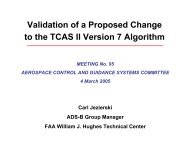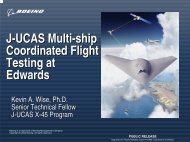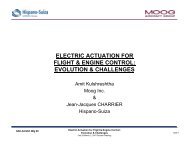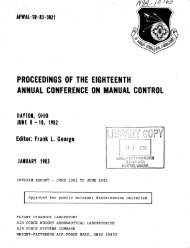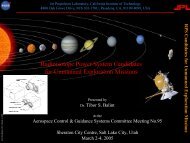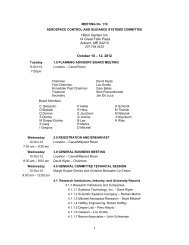Report of the Second Piloted Aircraft Flight Control System - Acgsc.org
Report of the Second Piloted Aircraft Flight Control System - Acgsc.org
Report of the Second Piloted Aircraft Flight Control System - Acgsc.org
Create successful ePaper yourself
Turn your PDF publications into a flip-book with our unique Google optimized e-Paper software.
her@ is to lnake <strong>the</strong> push-rod as stiff as possible, and increase <strong>the</strong><br />
damping fp as much as pemissible and <strong>the</strong>n live with <strong>the</strong>se components.<br />
It appears <strong>the</strong>n that in <strong>the</strong> absence <strong>of</strong> <strong>the</strong> abillty to effect arg<br />
'remarkable isprovaments in system components, <strong>the</strong> stabilloation <strong>of</strong> our<br />
system with <strong>the</strong> simultaneous realization <strong>of</strong> high performance characteristics 4<br />
demands <strong>the</strong> introduction <strong>of</strong> additjanal components. We ask ourselves what<br />
distortion <strong>of</strong> <strong>the</strong> pole confiwation we mw have for <strong>the</strong> opm-loop system<br />
would result in desirable characteristics. One particuhrly si@e<br />
configuration is shown in Fig. 13. We leave <strong>the</strong> two poles due to <strong>the</strong><br />
-<br />
stick dynamics at <strong>the</strong> origin ard -8.2, but move <strong>the</strong> conjugate compleeg<br />
poles due to <strong>the</strong> aerodynamics ei<strong>the</strong>r onto <strong>the</strong> negative-real axis or at<br />
least well out into <strong>the</strong> left-half plane. Now what happens as we close <strong>the</strong><br />
loop and increase <strong>the</strong> gain? The poles way out to <strong>the</strong> left are <strong>of</strong> little<br />
interest to us. The imporLant loci are those stemming from <strong>the</strong> two poles<br />
on <strong>the</strong> negative-real axis and close to <strong>the</strong> origin. At low frequencies,<br />
<strong>the</strong>se poles move as a function <strong>of</strong> gain in <strong>the</strong> manner shown in Fig. U.<br />
<strong>the</strong> addition <strong>of</strong> a zero at -10 and <strong>the</strong> moving <strong>of</strong> all o<strong>the</strong>r poles way out<br />
into <strong>the</strong> left-half plane we have kidded <strong>the</strong>se two poles into thinking we<br />
have a configuration <strong>of</strong> <strong>the</strong> farm shown in Fig. 15. It is not until we<br />
reach reasonably large values <strong>of</strong> loop gain and fairly high frequencies,<br />
that <strong>the</strong>se two poles realize <strong>the</strong> deception and bend over toward <strong>the</strong> righthalf<br />
plane. Then if we keep <strong>the</strong> gain at a value corresponding to <strong>the</strong>se<br />
poles located at <strong>the</strong> points A and 81, we have a closed-loop system, an<br />
overall aerodynamical system, uhich behaves eesentially as though it had<br />
this pole-zero configuration. The response is characteristized by one<br />
pair <strong>of</strong> conjugate complex poles at a reasonable damping ratio and a dipole<br />
on <strong>the</strong> negative real axis. The transient response will be roughly <strong>of</strong> <strong>the</strong><br />
shorn in Fig. 16.<br />
dseenthlly <strong>the</strong> earns results can be achieved by a slightly different,<br />
and basically more logical approach. Suppose we simply start <strong>of</strong>f by saying<br />
that we want a transient response <strong>of</strong> <strong>the</strong> form shown in Fig. 16. Int us<br />
write <strong>the</strong> overall syatm function, <strong>the</strong> Saplace transform <strong>of</strong> this transient<br />
response. We denote this desired closed-loop transfer fundion as ~(8).<br />
horn this ~ (a) we determine <strong>the</strong> required open-loop transfer function, which<br />
we migbt call p/q, <strong>the</strong> ratio <strong>of</strong> two polynomials in s. This opan-loop<br />
tranafer function, ~/q, is related to ~(8) a8 s hom at <strong>the</strong> bottom <strong>of</strong> PZig. 17. .<br />
p and q, <strong>the</strong> ~xumrator and denominator polynomials <strong>of</strong> <strong>the</strong> open-loop tranafer<br />
function are readily determined from this relationship. p is simply <strong>the</strong><br />
numerator <strong>of</strong> ~(8). q is simply <strong>the</strong> denominator <strong>of</strong> ~(8) minus <strong>the</strong> numarator,<br />
and can be determined in factored form by a simple graphical subtractian,<br />
-<br />
plotting <strong>the</strong> polpomials for negative-real values <strong>of</strong> <strong>the</strong> variable s. A plot<br />
<strong>of</strong> this form is &awn above <strong>the</strong> equations in Fig. 17.<br />
Let us review for a moment., We have said that our fundamental<br />
philosophy in <strong>the</strong> design <strong>of</strong> <strong>the</strong> power boost system' should be something<br />
like <strong>the</strong> following: We first decide on suitable specifications for our



